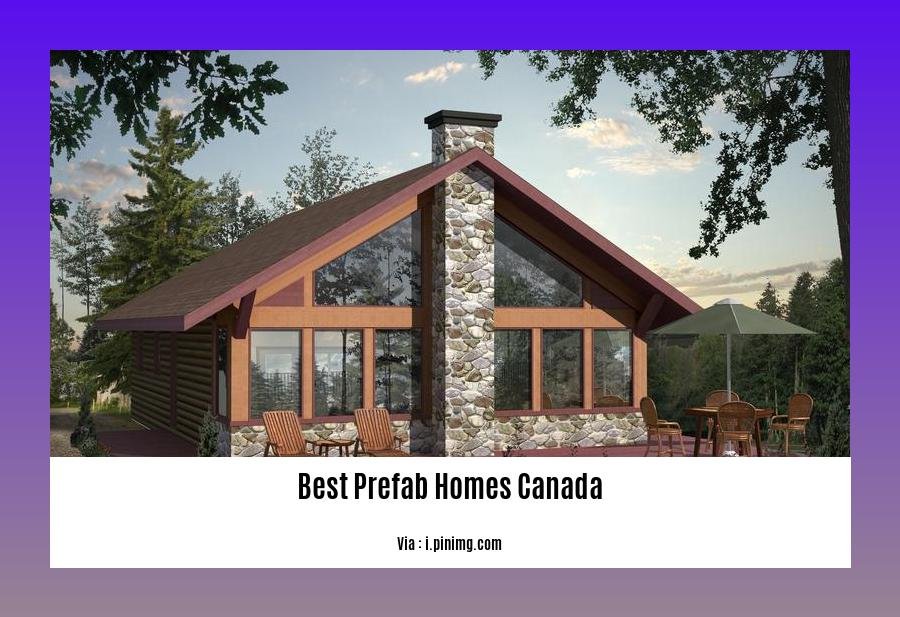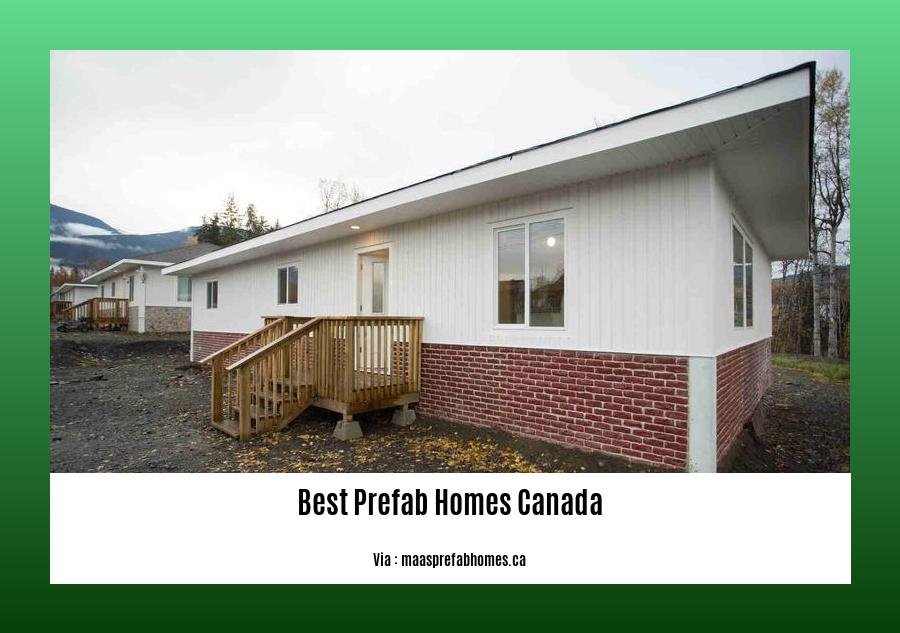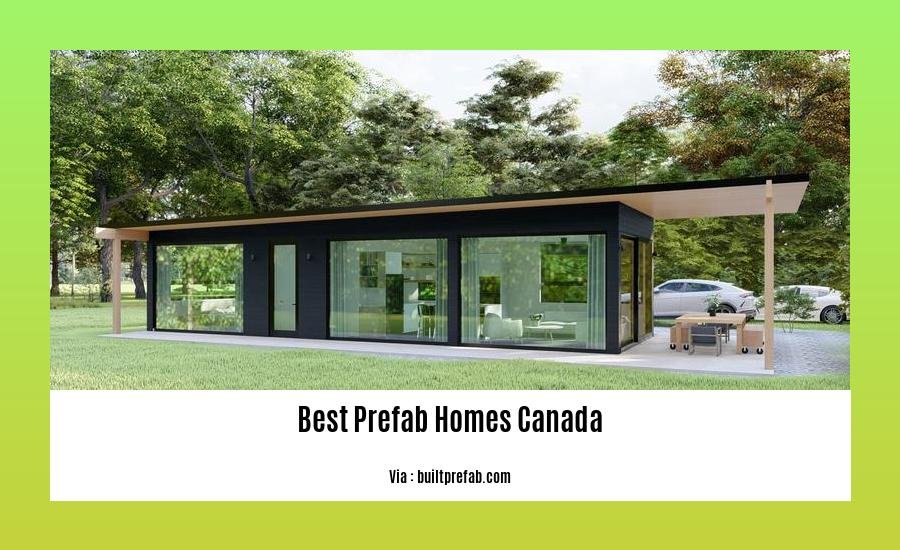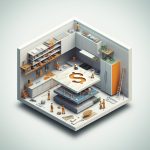Explore the world of prefab homes in Canada and uncover the best options that prioritize sustainability and cutting-edge design. Immerse yourself in the journey of discovering prefab homes that redefine the concept of modern living, merging eco-friendly practices with innovative architecture. [- Discover the Best Prefab Homes in Canada: Sustainable and Design-Forward Living]
Key Takeaways:
- Bonneville: Over 60 years of experience in modular design, offers modern and functional designs like the Aeroloft house.
- Honomobo: Ho4 cabin emphasizes modern and minimalist design, constructed with versatile rigid steel.
- East Coast Modern: Maintains a rural feel while embracing minimalism and functionality in its designs.
- New Classic 33 – Front by Jncn Homes: Modern rural-style building, focused on research and development for innovative design.
- Click Modular Homes: Uses high-quality materials and innovative construction methods in their modern modular homes.
Best Prefab Homes Canada

Prefab homes in Canada offer a sustainable and design-forward approach to modern living. These homes are revolutionizing the construction industry with their eco-friendly materials, innovative designs, and exceptional craftsmanship. Are you seeking a home that aligns with your values for sustainability, efficiency, and style? Let’s dive into the world of prefab homes in Canada and explore the reasons why they’re gaining popularity.
Embracing Sustainability:
Prefab homes are leading the way in sustainable living. Constructed using eco-friendly materials such as recycled steel, sustainably sourced wood, and energy-efficient insulation, these homes minimize environmental impact and promote a greener future. By reducing waste, conserving energy, and incorporating renewable energy sources, prefab homes are paving the way for a sustainable housing revolution.
Design Excellence:
Prefab homes are not just about sustainability; they’re also about stunning design. Architects and designers are pushing the boundaries of creativity, crafting prefab homes that blend seamlessly with their surroundings while embracing modern aesthetics. From minimalist retreats to cozy cabins, the variety of designs available ensures that you’ll find a prefab home that resonates with your personal style and lifestyle.
Precision and Quality Construction:
Prefab homes are constructed in controlled factory environments, ensuring exceptional precision and quality. This approach minimizes errors, reduces construction time, and results in homes that are built to last. The use of advanced technology and strict quality control measures ensures that prefab homes meet the highest standards of durability, safety, and performance.
Cost-Effective and Time-Saving:
Prefab homes offer significant cost savings compared to traditional construction methods. The streamlined manufacturing process and reduced labor costs allow for more affordable housing options without compromising on quality. Additionally, the rapid construction time of prefab homes means you can move into your dream home sooner.
Embark on Your Prefab Home Journey:
Explore the world of prefab homes in Canada and discover a new era of sustainable and design-forward living. Whether you’re seeking a cozy cabin in the mountains or a modern retreat by the ocean, the best prefab homes Canada offers endless possibilities. Embrace the future of housing and create a home that reflects your values, lifestyle, and commitment to the environment.
-
Discover the best manufactured homes in California that combine luxury, innovation, and affordability in perfect harmony.
-
Uncover the best prefab homes in New Zealand that seamlessly blend style, functionality, and eco-consciousness for a truly exceptional living experience.
-
Explore the best prefab homes in Ontario and immerse yourself in a world of customization, energy efficiency, and affordability.
-
Indulge in the best shopping in Naples, Florida where luxury boutiques, charming shops, and vibrant markets await your exploration.
-
Get acquainted with the biggest independent artists who are pushing the boundaries of music, art, and culture and leaving an indelible mark on the world.
-
Dive into the practicalities of building a tiny house in Ontario and discover how this innovative housing solution can unlock a life of freedom, sustainability, and affordability.
-
Take advantage of the cheap prefab homes available in Canada and experience the unparalleled benefits of modern design, exceptional quality, and affordability.
-
Explore the cheap prefab homes in New Zealand that offer a unique blend of affordability, sustainability, and innovative design, making homeownership a reality.
-
Discover the cheap prefab homes in Ontario that offer a perfect combination of affordability, style, and functionality, making homeownership an achievable dream.
Types of Prefab Homes: Examining Modular, Panelized, and Kit Homes and Their Unique Characteristics

Shopping for prefab homes in Canada? Let’s dive into the distinct types that await you – modular, panelized, and kit homes – to help you find the perfect prefab abode.
Modular Homes:
Picture a home built in modular sections, crafted in a factory, and then assembled on-site like a puzzle. These homes offer a variety of floor plans, giving you the freedom to customize your dream home. They’re also quick to build, taking a few weeks, saving you valuable time.
Panelized Homes:
These prefab homes are made up of prefabricated panels, constructed off-site and then assembled at the building site. Panelized homes provide more flexibility in design, allowing for unique architectural features. They’re known for their speedier construction, taking just days to erect, and they’re often more compact and space-efficient.
Kit Homes:
If you crave a hands-on approach, kit homes are just what you need. These homes arrive as pre-cut materials, and you’ll get the joy of assembling your own home. While they require more labor, they offer significant cost savings and the chance to customize your home to your heart’s desire.
Key Takeaways:
-
Modular homes: Built in sections, assembled on-site, quick construction, customizable floor plans.
-
Panelized homes: Prefabricated panels, assembled on-site, flexible design, expedited construction, space-efficient.
-
Kit homes: Pre-cut materials, self-assembly, cost-effective, customizable.
Citation
Citation
Prefab Homes in Canada: Market Overview, Key Players, and Recent Trends in Sustainable Housing Solutions
Canada's prefab homes market is taking off like a rocket! With a projected growth rate of over 3% annually, it's expected to reach a whopping USD 29.12 billion by 2028. Why the surge? Well, prefab homes offer a sustainable and cost-effective way to own a piece of the Canadian dream. They're produced in factories using eco-friendly materials and cutting-edge construction methods, resulting in reduced waste and a smaller carbon footprint. Plus, their modular design allows for faster assembly and customization.
Alta-Fab Structures, ATCO, Champion Home Builders, NRB Modular Solution, and Stack Modular. These builders aren't just constructing homes; they're shaping the future of sustainable living. Their dedication to innovation and environmental responsibility is transforming the housing industry.
The Canadian prefab homes market is not just about numbers and companies. It's driven by game-changing trends that are reshaping the way we live:
- **Energy Efficiency in Prefab Homes:**
Recent innovation in insulation, heating and cooling systems has led to prefab homes performing better than ever. Don't dread those energy bills; instead, enjoy a warm and cozy home while helping the environment!
- **Sustainability in Construction:**
Building prefab homes means less waste and reduced emissions. Recycled steel, sustainably sourced wood, energy-efficient insulation, and renewable energy features come standard and you can feel good about your impact on the planet.
- **Aesthetics and Customization:**
Far from being boring boxes, prefab homes now come in a vast range of styles both inside and out. Architects and designers are dreaming up captivating designs, from sleek contemporary to cozy cabins, ensuring you find a prefab home that matches your taste and lifestyle.
- **Affordability and Speed:**
Factory production means lower labor costs and faster construction times. The result? Prefab homes are more affordable and can be ready for you to move in sooner than traditional builds. Say goodbye to lengthy wait times and hello to your new home!
- **Research, Locate, and Enjoy:**
Discover the beauty of prefab homes in Canada by researching, visiting local builders and showrooms, and exploring online. Step into a prefab home and experience the next generation of sustainable living firsthand.
Key Takeaways:
-
Market growth: The Canadian prefab homes market is surging, with an expected CAGR of over 3% until 2028.
-
Sustainable construction: Prefab homes champion sustainability with eco-friendly materials, innovative methods, and reduced waste.
-
Leading players: ATCO, Champion Home Builders, NRB Modular Solution, and Stack Modular are key players driving the prefab homes revolution in Canada.
-
Recent trends: Energy efficiency, sustainability, aesthetics, affordability, and speed are shaping the evolution of prefab homes.
-
Explore and experience: Research, visit builders and showrooms, and step into a prefab home to immerse yourself in next-generation sustainable living.
Sources:
– Mordor Intelligence Canada Manufactured Homes Market
– Lucintel Canada Prefabricated Housing Market
Customizable Options and Design Considerations: Achieving Personalization and Architectural Versatility in Prefab Homes
In the realm of modern architecture, prefab homes have emerged as a sustainable and innovative solution to traditional construction methods. These homes, crafted in controlled factory environments, offer a myriad of customizable options and design considerations that cater to diverse lifestyles, aesthetics, and environmental concerns. In this article, we delve into the world of prefab homes in Canada, exploring the possibilities for personalization and architectural versatility that make them an attractive choice for homeowners seeking a unique and eco-conscious living space.
Key Takeaways:
-
Prefab homes offer a wide range of customizable options, allowing homeowners to tailor their living space to their specific needs, preferences, and architectural vision.
-
With prefab construction, homeowners can select from various floor plans, exterior finishes, interior layouts, and energy-efficient features to create a personalized living environment.
-
The modular nature of prefab homes enables flexibility in design, allowing for easy expansion or reconfiguration in the future, accommodating changing needs or family dynamics.
-
Prefab homes embrace sustainable and eco-friendly design principles, utilizing energy-efficient materials and construction methods to minimize environmental impact and promote a greener lifestyle.
-
Prefab construction offers a controlled and efficient building process, resulting in reduced construction time, waste, and noise pollution compared to traditional site-built homes.
Customizable Options for a Personalized Living Space
Prefab homes are not just about efficiency and sustainability—they can also be highly personalized to reflect the unique tastes and preferences of homeowners. With prefab construction, you have the freedom to choose from a range of customizable options, including:
-
Floor Plans: Select from a variety of pre-designed floor plans or work with an architect to create a custom layout that seamlessly integrates with your lifestyle and spatial requirements.
-
Exterior Finishes: Express your design sensibilities through a selection of exterior finishes, including siding materials, paint colors, and architectural accents that complement your home’s surroundings.
-
Interior Layouts: Personalize the interior of your prefab home by choosing room configurations, kitchen layouts, bathroom fixtures, and flooring options that create a cohesive and functional living space.
-
Energy-Efficient Features: Incorporate energy-efficient features such as solar panels, energy-efficient windows, and insulation to reduce your carbon footprint and create a more sustainable living environment.
-
Smart Home Technology: Integrate smart home technology to enhance convenience, security, and energy efficiency, allowing you to control lighting, heating, and entertainment systems with just a few taps on your smartphone.
Design Considerations for Architectural Versatility
Beyond personalization, prefab homes offer a remarkable degree of architectural versatility, allowing you to explore a diverse range of design styles and adapt your home to different terrains and climatic conditions. Consider these design considerations:
-
Modern and Minimalist: Embrace the sleek lines and open spaces of modern architecture, creating a clean and contemporary living environment.
-
Rustic and Natural: Opt for natural materials like wood and stone to blend your home seamlessly into its surroundings, evoking a sense of warmth and connection with nature.
-
Traditional and Craftsman: Incorporate traditional architectural elements such as gabled roofs, porches, and intricate millwork to create a classic and timeless aesthetic.
-
Sustainable and Eco-Conscious: Design your prefab home with a focus on sustainability, using recycled materials, energy-efficient systems, and renewable energy sources to minimize your environmental impact.
-
Adaptable and Flexible: Consider the long-term potential of your prefab home by designing for adaptability and flexibility. This could include the ability to add on additional modules or reconfigure the interior layout to accommodate changing needs or family dynamics.
Conclusion:
Prefab homes in Canada represent a transformative approach to modern living, offering customizable options and design considerations that cater to diverse lifestyles, aesthetics, and environmental concerns. Whether you seek a personalized living space, a sustainable and eco-conscious home, or a versatile design that adapts to your evolving needs, prefab construction provides endless possibilities for creating a unique and exceptional living environment.
Sources:
-
[Prefab Homes Canada: The Ultimate Guide]
-
[Customizable Prefab Homes: A Guide to Personalizing Your Prefab Home]
FAQ
Q1: What are the advantages of prefab homes over traditional construction methods?
A1: Prefab homes offer numerous advantages, including reduced construction time, minimized waste, improved energy efficiency, greater sustainability, and cost-effectiveness. They also provide flexibility in design and customization, allowing homeowners to create unique living spaces.
Q2: What are the leading prefab home manufacturers in Canada?
A2: Canada boasts several reputable prefab home manufacturers, such as Bonneville, Honomobo, East Coast Modern, Jncn Homes, and Click Modular Homes. These companies are renowned for their innovative designs, high-quality materials, and commitment to sustainability.
Q3: Are prefab homes suitable for diverse terrains and weather conditions?
A3: Prefab homes are designed to adapt to various terrains and weather conditions. They can be customized to withstand extreme temperatures, seismic activity, and high winds. This versatility makes them an ideal choice for regions prone to natural disasters.
Q4: How does prefab construction contribute to sustainable living?
A4: Prefab construction promotes sustainable living by minimizing waste, reducing energy consumption, and utilizing eco-friendly materials. Prefab homes are often designed with energy-efficient features, such as solar panels, rainwater harvesting systems, and sustainable insulation, leading to a lower carbon footprint.
Q5: What are the long-term benefits of investing in a prefab home?
A5: Investing in a prefab home offers several long-term benefits. Prefab homes are generally more durable and require less maintenance compared to traditional homes. They also appreciate in value over time due to their energy efficiency and sustainable features. Additionally, prefab homes can be easily modified or expanded to accommodate changing needs.
- White Kitchen With Butcher Block Countertops: A Warm, Inviting Design - January 4, 2026
- Marble Countertops Prices: What Impacts the Overall Cost to Install? - January 3, 2026
- Marble Countertops Cost: What Factors Impact the Total Price? - January 2, 2026










